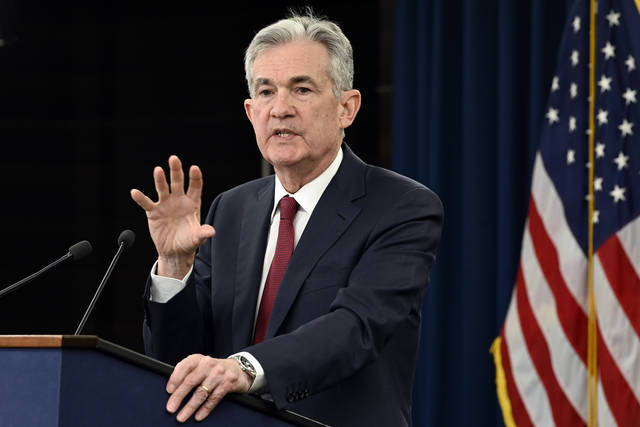WASHINGTON — The Federal Reserve held its benchmark interest rate steady Wednesday and sent its strongest signal to date that it sees no need to raise rates anytime soon. Its message ignited a rally on Wall Street, which cheered the prospect of continued modest borrowing rates for the near future.
The Fed and its chairman, Jerome Powell, pointed to global economic pressures and consistently mild inflation as reasons to keep rates steady. The policymakers also said they’re prepared to slow the reduction of their bond holdings if needed to help the economy.
In a statement after its latest policy meeting, the Fed said it would be “patient” about future rate hikes. Its benchmark short-term rate will remain in a range of 2.25 percent to 2.5 percent after having been raised four times last year. The Fed’s key rate influences many loan rates for businesses and consumers, including mortgages.
The picture sketched by Powell and the Fed was of a U.S. economy that remains on firm footing with low inflation but that faces risks from a global slowdown and a U.S. trade war with China.
“The situation calls for patience,” Powell said at a news conference afterward. “We have the luxury to be patient.”
Before raising rates again, Powell said, he would need to see rising inflation. The Fed’s preferred inflation gauge has risen 1.8 percent in the past 12 months, below its 2 percent annual target.
“I would want to see a need for further rate increases, and for me a big part of that would be inflation,” the chairman said.
Pleased by the Fed’s benign outlook, investors sent the Dow Jones Industrial Average up nearly 435 points and back above the 25,000 level.
The central bank said in its statement that it’s ready to use all its tools — including an adjustment to its bond portfolio — if it decided the economy needed more support. Since late 2017, the Fed has been gradually reducing its bond portfolio, a move that has likely contributed to higher borrowing rates. But at some point, to avoid weakening the economy, it could slow that process or end it sooner than envisioned. Doing so would help keep a lid on loan rates and help support the economy.
The Fed’s note of patience about rate hikes marks a reversal from a theme that Powell had sounded at a news conference after the Fed’s previous policy meeting in December. Powell had appeared then to leave open the prospect of further increases soon. This message had sparked fears in financial markets that the Fed might tighten credit too aggressively this year, and the Dow sank over 350 points that day.
“I think he got an education by the markets and got burned,” said Kathy Bostjancic, chief U.S. financial market economist at Oxford Economics. “Now, they’re bending over backward to show they’re sensitive” to the market.
Bostjancic suggested that Powell wants to convey that he is mindful of the economic risks that are worrying investors, including weakening global growth, the U.S. trade war with China and Britain’s struggles to achieve a smooth exit from the European Union. If he didn’t, she said, markets might tumble further and borrowing costs could rise, thereby threatening the Fed’s goals of maximizing employment and stabilizing prices.
Now, in light of such global pressures, the Powell Fed is now signaling that it’s in no hurry to resume raising rates. And with inflation remaining tame, the rationale to tighten credit has become less compelling.
Still, the Fed is having to maintain a delicate balancing act because some gauges of the economy look healthy. The job market, for example, remains robust, with solid and steady hiring. And corporate earnings have so far been holding up in the face of the global slowdown and trade conflicts. Of the companies in the Standard & Poor’s 500 that have reported results for the final three months of 2018, 77 percent have delivered earnings growth that topped Wall Street’s forecasts. Some, though, are lowering expectations for 2019.
Since the Fed’s December meeting, Powell and others on the Fed’s policy committee have been clear in suggesting that they’re in no rush to raise rates again after having done so nine times over the past three years. Besides invoking the word “patient” to describe the Fed’s approach to future hikes, Powell has stressed that the Fed will tailor its rate policy to the latest economic data.
In its statement Wednesday, the Fed said, “In light of global economic and financial developments and muted inflation pressures, the committee will be patient in determining what future adjustments” to the Fed’s interest-rate policy will be appropriate.
The Fed’s decision was approved on a 10-0 vote.
The assurances from the central bank have helped allay fears that higher borrowing costs might depress corporate earnings and economic growth. They have also helped spur a stock market rally. With the turnaround, stocks are on pace for their best month since March 2016.
In recent weeks, though, the Fed has been hamstrung in its effort to assess the health of the economy. That’s because the partial shutdown of the government that ended late last week — at least until mid-February — essentially closed the Commerce and Treasury departments, among other agencies. So economic data that those departments normally issue — involving retail sales, home construction and factory orders, among others — wasn’t available to the Fed.
Beginning Thursday, though, the government will start gradually distributing the delayed economic reports.
———
AP Business Writers Josh Boak and Christopher Rugaber in Washington and Alex Veiga in Los Angeles contributed to this report.


